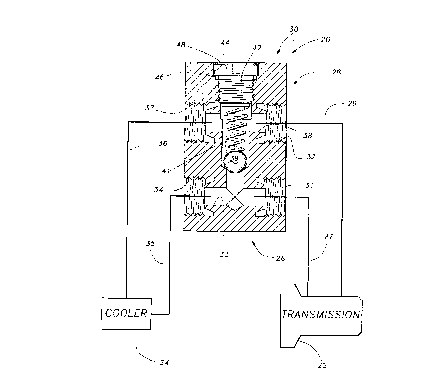Une partie des informations de ce site Web a été fournie par des sources externes. Le gouvernement du Canada n'assume aucune responsabilité concernant la précision, l'actualité ou la fiabilité des informations fournies par les sources externes. Les utilisateurs qui désirent employer cette information devraient consulter directement la source des informations. Le contenu fourni par les sources externes n'est pas assujetti aux exigences sur les langues officielles, la protection des renseignements personnels et l'accessibilité.
L'apparition de différences dans le texte et l'image des Revendications et de l'Abrégé dépend du moment auquel le document est publié. Les textes des Revendications et de l'Abrégé sont affichés :
| (12) Brevet: | (11) CA 2179366 |
|---|---|
| (54) Titre français: | SOUPAPE DE DECHARGE MONOPIECE DESTINEE AUX SYSTEMES DE REFROIDISSEMENT DE TRANSMISSION |
| (54) Titre anglais: | ONE-PIECE PRESSURE RELIEF VALVE FOR TRANSMISSION COOLING SYSTEM |
| Statut: | Durée expirée - au-delà du délai suivant l'octroi |
| (51) Classification internationale des brevets (CIB): |
|
|---|---|
| (72) Inventeurs : |
|
| (73) Titulaires : |
|
| (71) Demandeurs : |
|
| (74) Agent: | GOWLING WLG (CANADA) LLP |
| (74) Co-agent: | |
| (45) Délivré: | 2000-03-21 |
| (22) Date de dépôt: | 1996-06-18 |
| (41) Mise à la disponibilité du public: | 1997-02-08 |
| Requête d'examen: | 1997-05-22 |
| Licence disponible: | S.O. |
| Cédé au domaine public: | S.O. |
| (25) Langue des documents déposés: | Anglais |
| Traité de coopération en matière de brevets (PCT): | Non |
|---|
| (30) Données de priorité de la demande: | ||||||
|---|---|---|---|---|---|---|
|
Une soupape de décharge monopièce est incorporée dans un système de refroidissement d'une transmission. La soupape de décharge monopièce remplace le système de l'état de la technique précédent qui utilise plusieurs connexions en T pour obtenir les fonctions de la soupape de décharge. La soupape de décharge monopièce réduit le nombre de connexions fluides sur le système de refroidissement de la transmission, ce qui réduit la possibilité de fuite.
A one-piece relief valve is incorporated into a transmission cooling system. The one-piece relief valve replaces the prior art system which have usedplural T-connections to achieve the relief valve fun ction. The one-piece relief valve reduces the number of fluid connections on the transmission cooling system, thus reducing the possibility of leakage.
Note : Les revendications sont présentées dans la langue officielle dans laquelle elles ont été soumises.
Note : Les descriptions sont présentées dans la langue officielle dans laquelle elles ont été soumises.

2024-08-01 : Dans le cadre de la transition vers les Brevets de nouvelle génération (BNG), la base de données sur les brevets canadiens (BDBC) contient désormais un Historique d'événement plus détaillé, qui reproduit le Journal des événements de notre nouvelle solution interne.
Veuillez noter que les événements débutant par « Inactive : » se réfèrent à des événements qui ne sont plus utilisés dans notre nouvelle solution interne.
Pour une meilleure compréhension de l'état de la demande ou brevet qui figure sur cette page, la rubrique Mise en garde , et les descriptions de Brevet , Historique d'événement , Taxes périodiques et Historique des paiements devraient être consultées.
| Description | Date |
|---|---|
| Inactive : Périmé (brevet - nouvelle loi) | 2016-06-18 |
| Inactive : CIB désactivée | 2011-07-29 |
| Inactive : CIB attribuée | 2010-03-11 |
| Inactive : CIB en 1re position | 2010-03-11 |
| Inactive : CIB expirée | 2010-01-01 |
| Inactive : CIB de MCD | 2006-03-12 |
| Inactive : TME en retard traitée | 2005-07-22 |
| Lettre envoyée | 2005-06-20 |
| Accordé par délivrance | 2000-03-21 |
| Inactive : Page couverture publiée | 2000-03-20 |
| Préoctroi | 1999-12-15 |
| Inactive : Taxe finale reçue | 1999-12-15 |
| Un avis d'acceptation est envoyé | 1999-10-20 |
| Lettre envoyée | 1999-10-20 |
| Un avis d'acceptation est envoyé | 1999-10-20 |
| Inactive : Approuvée aux fins d'acceptation (AFA) | 1999-09-29 |
| Inactive : Acc. réc. RE - Pas de dem. doc. d'antériorité | 1997-09-18 |
| Inactive : Dem. traitée sur TS dès date d'ent. journal | 1997-09-16 |
| Inactive : Renseign. sur l'état - Complets dès date d'ent. journ. | 1997-09-16 |
| Toutes les exigences pour l'examen - jugée conforme | 1997-05-22 |
| Exigences pour une requête d'examen - jugée conforme | 1997-05-22 |
| Demande publiée (accessible au public) | 1997-02-08 |
Il n'y a pas d'historique d'abandonnement
Le dernier paiement a été reçu le 1999-04-20
Avis : Si le paiement en totalité n'a pas été reçu au plus tard à la date indiquée, une taxe supplémentaire peut être imposée, soit une des taxes suivantes :
Les taxes sur les brevets sont ajustées au 1er janvier de chaque année. Les montants ci-dessus sont les montants actuels s'ils sont reçus au plus tard le 31 décembre de l'année en cours.
Veuillez vous référer à la page web des
taxes sur les brevets
de l'OPIC pour voir tous les montants actuels des taxes.
Les titulaires actuels et antérieures au dossier sont affichés en ordre alphabétique.
| Titulaires actuels au dossier |
|---|
| FORM RITE |
| Titulaires antérieures au dossier |
|---|
| ALAN S. GILROY |
| DENNIS C. GAIDA |